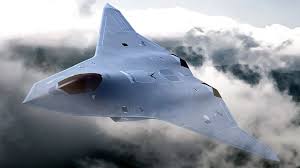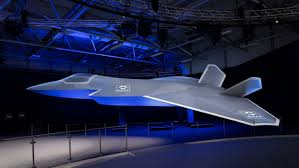
6TH GEN FIGHTER GETS
INTRODUCTION
A sixth-generation fighter is a conceptualized class of jet fighter aircraft design more advanced than the fifth-generation jet fighters that are currently in service and development.
Several countries have announced the development of a national sixth-generation aircraft program, including China, the United States, and Russia. Other countries have joined collaborative multinational projects, such as Japan, Italy, and the United Kingdom with Global Combat Air Programme, and France, Germany, and Spain with FCAS in order to spread development and procurement costs. The first sixth-generation fighters are expected to enter service in the 2030s.


CHARACTERISTICS
Typical design characteristics anticipated to deliver these roles include:
- Designed using digital engineering (aka model-based design)
- Advanced digital capabilities including high-capacity networking, artificial intelligence, data fusion, cyber warfare, data-to-decision and battlefield command, control and communications (C3) capabilities.
- Optionally manned, with the same airframe capable of conducting piloted, remote controlled or onboard-AI controlled missions.
- Enhanced human-systems integration, with virtual cockpits presented via helmet-mounted displays which allow the pilot 360-degree vision with AI-enhanced battlefield awareness, and replacing conventional instrument panels.
- Advanced stealth airframes and avionics.
- Advanced variable-cycle engines able to cruise economically but still deliver high thrust when required.
- Increased-range stand-off and beyond-visual-range weapons.
- Potential use of directed-energy weapons such as a laser close-in weapon system (CIWS).
- Software architecture with separation of flight critical operations from other functionality
- Potential capability for suborbital flight to achieve global reach, evade defenses, and satellite operations.
The feasibility of some of these characteristics remains uncertain. Development time and cost are likely to prove major factors in laying out practical roadmaps. Specific requirements are anticipated by some observers to crystallize around 2025
WORKING OF 6TH GEN FIGHTER GETS:

WORKING
1. Stealth and Low Observability
- Advanced Stealth: The 6th-gen fighter is expected to take stealth to new levels, not just by reducing radar cross-section (RCS) but by incorporating more advanced techniques like radar-absorbing materials, adaptive camouflage, and perhaps even the ability to modify its shape for different missions.
- Reduced IR Signature: The aircraft would likely employ next-gen heat management systems to minimize its infrared (IR) signature, making it harder for heat-seeking missiles or sensors to detect.
2. Artificial Intelligence and Autonomous Operations
- AI-Powered Decision Making: 6th-gen fighters are expected to feature onboard AI systems that can assist the pilot or even allow the aircraft to operate autonomously. AI can process vast amounts of data from sensors and make real-time tactical decisions, enhancing mission success.
- Drone Control: Many 6th-gen fighters will likely have the ability to control a fleet of unmanned aerial vehicles (UAVs) or drones. These drones could act as decoys, additional sensors, or weapons platforms, extending the reach and versatility of the fighter.
3. Next-Generation Sensors
- Advanced Radar: The fighter will incorporate advanced radar systems, such as active electronically scanned array (AESA) radar, capable of detecting enemy aircraft and ground targets from longer ranges and through more cluttered environments.
- Integrated Sensor Fusion: All of the fighter’s sensors (radar, infrared, electronic warfare systems) will be seamlessly integrated, providing the pilot with a single, comprehensive tactical picture. The ability to fuse data from multiple sources, including from nearby assets, would improve situational awareness.
- Hyperspectral and Quantum Sensors: Future fighters may utilize hyperspectral imaging to detect a broader range of electromagnetic frequencies or even quantum sensors for more precise targeting.
4. Supercruise and Hypersonic Speeds
- Supercruise: The 6th-gen fighter is likely to maintain supersonic speeds without the need for afterburners, enhancing both fuel efficiency and stealth. This capability will allow the fighter to penetrate enemy air defenses at high speeds without giving away its position.
- Hypersonic Capabilities: Some 6th-gen designs may include hypersonic flight (speeds over Mach 5), which could significantly reduce mission time and enable the fighter to outrun modern air defenses.
5. Directed Energy Weapons
- Laser Systems: Future 6th-gen fighters might be equipped with laser weapons or directed-energy systems, capable of disabling enemy missiles, aircraft, or even ground targets. These weapons are still in development, but their inclusion in a future fighter aircraft could be revolutionary, offering an infinite ammo supply and the ability to strike at the speed of light.
ADVANTAGES:
AI and Autonomous Capabilities
- AI-Enhanced Operations: 6th-gen fighters will likely feature advanced artificial intelligence (AI) that can assist pilots or even operate the aircraft autonomously in certain situations. This allows for more efficient decision-making, quicker responses in combat, and reduced pilot workload. The AI can also help manage complex systems, conduct real-time battlefield analysis, and control multiple drones or unmanned systems, amplifying the fighter’s operational capabilities.
2. Next-Generation Stealth and Supercruise
- Superior Stealth: The 6th-gen fighter will have even more advanced stealth technology, making it harder to detect by enemy radar, infrared sensors, and other tracking systems. This allows the fighter to operate in high-risk environments and penetrate well-defended airspaces with minimal detection.
- Supercruise Capability: The fighter will be able to fly at supersonic speeds without using afterburners, enhancing both fuel efficiency and stealth. This allows it to cover greater distances quickly while maintaining a low radar signature.
DISADVANTAGES:
High Cost and Maintenance Complexity
- Expensive Development and Production: Due to the advanced technology and cutting-edge materials required for a 6th-gen fighter, the cost of development, production, and procurement is expected to be extremely high. This could limit the number of aircraft a country can deploy, making them less accessible and more resource-intensive to maintain.
- Complex Maintenance: The advanced systems, AI, and cutting-edge avionics could require highly specialized maintenance, creating challenges in terms of repair, parts availability, and overall upkeep. This can lead to higher operational costs and longer downtime for aircraft.
2. Vulnerability to Cyber Threats
- Increased Dependence on AI and Connectivity: The heavy reliance on AI systems and interconnected technologies (such as drone control, real-time data sharing, and advanced sensors) makes 6th-gen fighters vulnerable to cyberattacks. Adversaries could potentially exploit software vulnerabilities, hack into communication systems, or disrupt the AI’s decision-making process, compromising the fighter’s performance and mission success.
- AI Limitations: Although AI offers advanced operational benefits, it could still face limitations in unpredicted or unconventional combat scenarios, where human judgment and adaptability are critical. Hackers or electronic warfare tactics could also manipulate the fighter’s AI systems, creating risks in high-stakes combat situations.

